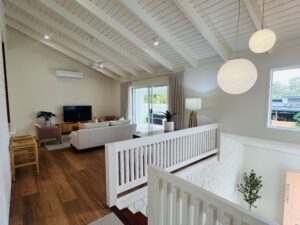What to consider when installing lights or fans in a racked or vaulted ceiling
When installing light fittings in a racked ceiling (also known as a vaulted or cathedral ceiling) versus a normal ceiling, there are several key differences to consider, both in terms of installation techniques and aesthetic results.
Many homes in Brisbane have architecture which include these beautiful high ceilings. Usually found in larger rooms within a home, such as lounge or dining rooms, making the areas feel light and spacious.
When installing new lighting in a ceiling such as this, there are a few things to consider.
1. Height & Accessibility
-
Racked Ceiling: Typically, a racked ceiling is higher than a standard flat ceiling, which can make installation more challenging. You’ll likely need ladders, scaffolding, or even a lift to safely reach the desired height. The additional cost associated with this needs to be considered.
-
Regular Ceiling: With standard ceiling heights, installation is much easier and safer, as it’s more accessible.
2. Light Placement & Coverage
-
Racked Ceiling: The sloping nature of the ceiling can create mean that you will require light fixtures which will avoid any uneven distribution of light (eg dark shadows). areas where the light distribution may be uneven. When installing lights, you have to account for the angle of the slope and ensure that the lights are positioned in a way that effectively illuminates the entire space.
-
If using recessed lighting, you’ll need to angle the fixtures correctly or use adjustable trims to direct the light where you want it.
-
Adjustable rods and chains help pendant lights accommodate to the slope.
-
-
Regular Ceiling: Light placement is more straightforward, and there’s less consideration needed for light direction since the ceiling is level.
3. Types of Fixtures
-
Racked Ceiling: Sloped ceilings often require specialized lighting solutions. Some fixtures can be angled, like adjustable recessed lighting or chandeliers designed with long chains to hang lower and stay level.
-
Chandeliers often look great in a racked ceiling, but their suspension length might need adjusting to maintain balance and alignment.
-
Pendant lights can be hung at varying lengths using rods or chains that can adjust to the height of the ceiling.
- Directional lights can be easily attached on a mounting block to help level the fitting out for better attachment and asthetics.
-
-
Regular Ceiling: More options are available for standard fixtures (e.g., flush-mount lights, ceiling fans with light kits, recessed lights, track lighting), and there are fewer considerations for height and balance.
4. Electrical Wiring Considerations
-
Racked Ceiling: Ceilings with high pitches also often do not have as much cavity space, and inserting extra wiring can also be more difficult. There might be the need for installation of junction boxes at various places or special mounting hardware for fixtures.
-
Wires can be run along rafters or beams, but may require additional planning and access in ceiling space. In some cases, the wiring may even be exposed and take additional time. Your electrician will provide options which best suit.
-
-
Regular Ceiling: Electrical wiring installation is usually not as difficult and with more access and less high issues, junction boxes and the like can be placed in usual positions quicker and easier.
Updating your light fixtures is a great way to update your home.
Call our team today and let us help you get the best outcome for your home – 1300 38 55 99.




